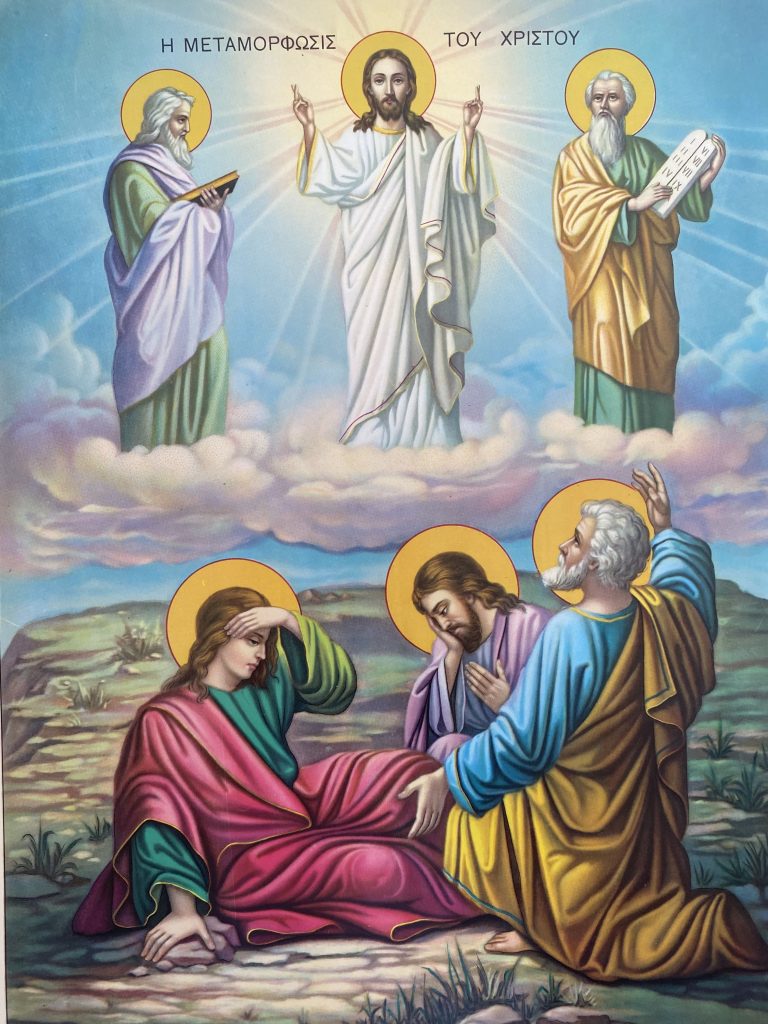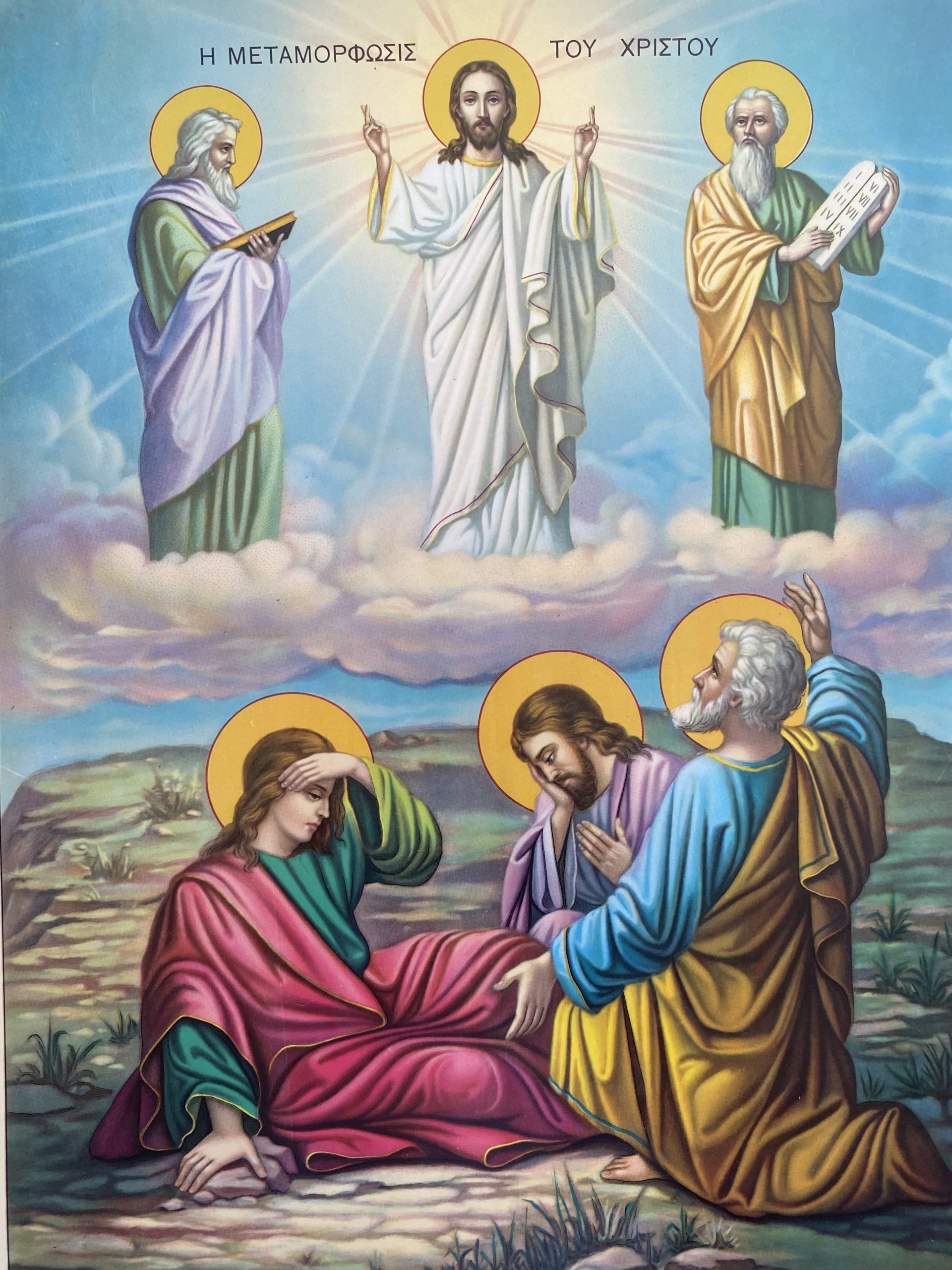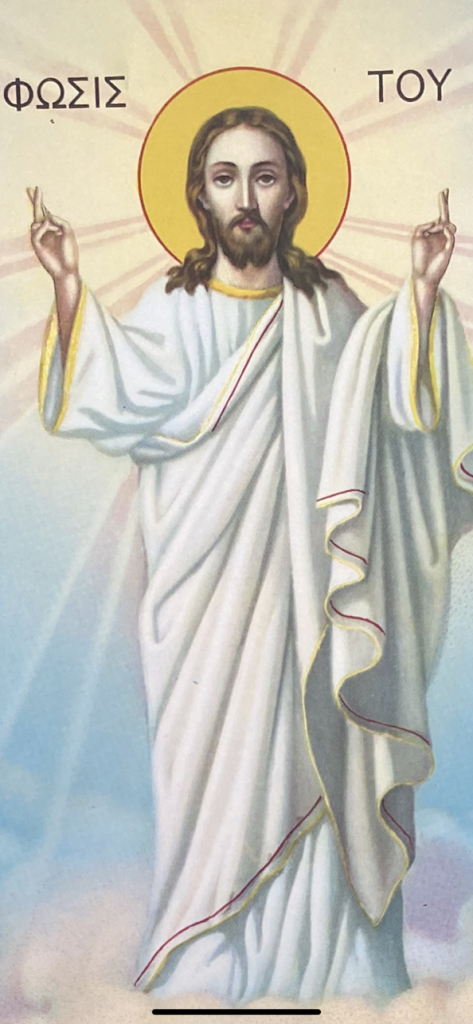
A transfiguração do Senhor Jesus Cristo no monte Tabor – Elias, Moisés, Pedro, João e Tiago – Stefanos, Bispo de Arsinoe


Aprecie o ícone da Transfiguração e conheça a história deste nos filmes adiante:
Filmes sobre o ícone e sobre o evento da Transfiguração de Jesus:
Lendo o ícone da Transfiguração
“A transfiguração é o que o ser humano pode receber pela graça.”
O ícone da Transfiguração
O ícone da Transfiguração normalmente descreve-o como uma manifestação artística profunda e teologicamente rica.
Ele enfatiza a maneira como o ícone transmite a divindade de Cristo e o evento da Transfiguração como um momento de revelação divina.
Passarelli destaca a composição simétrica do ícone, com Cristo no centro emanando luz, ladeado por Moisés e Elias, representando a Lei e os Profetas, respectivamente.
A montanha onde ocorre a Transfiguração simboliza o ponto de encontro entre o céu e a terra, e os discípulos, muitas vezes retratados em posturas de admiração e temor, representam a humanidade confrontada com o divino.
Este ícone é interpretado por Passarelli não apenas como uma obra de arte, mas como uma janela teológica que convida à meditação e à compreensão mais profunda do mistério da fé.
A descrição do ícone da Transfiguração, seguindo a interpretação de especialistas como Passarelli, pode ser enriquecida por detalhes que ressaltam sua complexidade e beleza:
Descobrimos por meio do ícone da Transfiguração que também podemos fazer parte da natureza divina. Nós também podemos ver a luz não criada no fim dos tempos.
Este ícone, portanto, não é apenas uma representação de um evento bíblico, mas uma meditação visual sobre a natureza de Cristo, a relação entre Deus e a humanidade, e a promessa da salvação.
Ele convida o espectador a uma reflexão profunda sobre esses mistérios.
Diz a tradição eclesiástica que a Transfiguração ocorreu 40 dias antes da crucificação, porém, foi transferida por que as honras da quaresma foram tidas como mais importantes e mais dolorosas, a festa da Transfiguração foi transferida de data.
Na igreja ortodoxa, a Transfiguração é comemorada dia 6 de agosto.
Fonte: Escrito com texto aprimorado do Aplicativo de Inteligência Artificial – Genie
Transcrição do Filme: The Icon of Transfiguration – Canal Trisagion
Em 6 de agosto, os Cristãos Ortodoxos celebram a Festa da Transfiguração de nosso Senhor e Salvador Jesus Cristo.
Antes da Transfiguração, os discípulos seguiram Jesus enquanto ele ensinava na Galiléia, eles estavam crescendo na fé e no entendimento, com Pedro finalmente confessando que Jesus era o Cristo, o Filho de o Deus Vivo.
Agora, enquanto eles se voltavam para Jerusalém, Jesus começou a prepará-los e fortalecê-los ainda mais para sua paixão vindoura, ele até predisse a experiência da Transfiguração, com certeza eu vos digo que há alguns aqui que não provarão a morte até que vejam o Filho do homem vindo em seu reino.
Seis dias depois, Cristo subiu ao Monte Tabor para orar, levando consigo Pedro Tiago e João, seus três discípulos mais próximos, como lemos nos Evangelhos sinópticos, enquanto Cristo orava, os discípulos adormeceram.
Depois de algum tempo, eles acordaram de repente e o encontraram de pé no pico do Monte Tabor com a luz incriada irradiando dele, seu rosto brilhando como o Sol e suas roupas tornando-se de um branco deslumbrante.
Suas energias divinas são representadas pela mandorla que o rodeia e dela vemos três raios de luz apontando para baixo sobre os apóstolos mostrar a ação da Santíssima Trindade sobre eles neste momento e Cristo revela sua divindade não é algo acrescentado algo criado ou outra natureza mas sim é sua natureza divina eterna que pode ser vista através de uma revelação como foi concedida aos discípulos.
Neste momento é a divindade que se uniu à sua natureza humana desde o momento da sua concepção através do Espírito Santo e da Virgem Maria e agora brilha revelando o mistério que estava escondido no Antigo Testamento.
Moisés e Elias encontraram o logos divino. sarça ardente e na nuvem no Sinai Elias na brisa suave no Monte Horeb na sombra do Monte Sinai e ainda assim agora aqui estão eles de cada lado da Palavra de Deus encarnada falando com ele cara a cara sobre os eventos vindouros Moisés e Elias representam a lei e os profetas dos quais Jesus é o cumprimento.
Para os três apóstolos este é um momento de grande tudo e revelação seus olhos foram abertos, seus sentidos e compreensão transformada movendo-se como São João de Damasco diz da carne ao espírito e experimentando Cristo como ele realmente é, tanto quanto eles foram capazes de suportar isso.
Pedro gritou Senhor, é bom para nós estarmos aqui, se você deseja, vamos fazer aqui três barracas, uma para você, uma para Moisés e outro para Elias foi tão doce este momento que Pedro não queria que terminasse.
Este foi o momento que Cristo predisse uma semana antes dos três apóstolos terem um vislumbre do reino de Deus no aqui e agora eles estavam vendo Jesus na glória da luz incriada de seu reino, como uma verificação disso, uma nuvem brilhante os cobriu e de repente uma voz saiu da nuvem dizendo:
“Este é meu filho amado, com quem estou muito satisfeito”, ouça-o, o brilho da visão e o som da voz foi demais para os três discípulos suportarem e eles caíram de cara no chão e ficaram com muito medo os discípulos estavam testemunhando uma manifestação da Santíssima Trindade, uma engraçada uma revelação de Deus.
Assim como tinham visto no batismo de Cristo pois enquanto Cristo está transfigurado acima deles a voz do pai é ouvida do alto a nuvem representa o Espírito Santo e é representada pelos círculos ao redor da mandorla de Jesus para os discípulos esta foi uma grande revelação e uma experiência poderosa um vislumbre do reino para venha experimentado aqui e agora.
Como são Pedro escreveria mais tarde, nós também podemos nos tornar participantes da natureza divina, nós também podemos ver a luz incriada quando o momento presente terminar, Cristo tocou os apóstolos e disse: levantem-se e não tenham medo.
De acordo com a tradição, a Transfiguração ocorreu 40 dias antes da crucificação, mas porque a Quaresma é um período mais doloroso e penitencial no calendário eclesial, a festa foi transferida para agosto, onde ocorre 40 dias antes da festa da exaltação da Santa Cruz.
Aqui o brilho da festa pode ser apreciado, mantendo ao mesmo tempo a sua ligação com o Paixão de Cristo, pois embora seja através da cruz e da ressurreição que a alegria vem ao mundo, é através da Transfiguração que recebemos um vislumbre do reino de Deus e uma imagem daquilo que o homem pode tornar-se pela graça.
Fonte do ícone: Aperges.
Divulgado por:

Consulte a Agenda do Museu a partir de 2025 e o visite quando receber sua confirmação de visita em seu email ou whatsapp.
Por se tratar de um museu particular, é necessário se cadastrar na Comunidade MuMi e customizar sua visita.
Criação e Tecnologia: Clayton Tenório @2025 MuMi – Museu Mítico